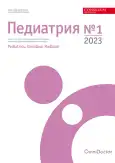Topical issues of the use of meat in baby food: A review
- Authors: Pyrieva E.A.1, Safronova A.I.1, Timoshina M.I.1
-
Affiliations:
- Federal Research Center of Nutrition, Biotechnology and Food Safety
- Issue: No 1 (2023)
- Pages: 30-33
- Section: Articles
- URL: https://pediatria.orscience.ru/2658-6630/article/view/472156
- DOI: https://doi.org/10.26442/26586630.2023.1.202124
- ID: 472156
Cite item
Full Text
Abstract
Meat is one of the main food products, as it is an valuable source of proteins containing all the essential amino acids, some mineral products, primarily iron and zinc. Meat products are an obligatory component of the diet throughout the entire childhood. The results of the assessment on the role of meat in ensuring the health of children, as well as the impact of inadequate intake on cognitive and motor functions, bone condition, etc. are presented. The article presents data on the evaluation of the role of meat in the concept of food programming. Specialized baby food products have undeniable advantages in the nutrition of young children. Standards are established for this category of products, which include regulated requirements for raw meat, ingredients, product quality, labeling, packaging, transportation and storage. These requirements guarantee high quality products with great nutritional and biological value.
Full Text
About the authors
Ekaterina A. Pyrieva
Federal Research Center of Nutrition, Biotechnology and Food Safety
Author for correspondence.
Email: epyrieva@mail.ru
ORCID iD: 0000-0002-9110-6753
Cand. Sci. (Med.)
Russian Federation, MoscowAdilya I. Safronova
Federal Research Center of Nutrition, Biotechnology and Food Safety
Email: sai1509@yandex.ru
ORCID iD: 0000-0002-6023-8737
Cand. Sci. (Med.)
Russian Federation, MoscowMarina I. Timoshina
Federal Research Center of Nutrition, Biotechnology and Food Safety
Email: mtimoshina03@gmail.com
ORCID iD: 0000-0002-2882-5704
Res. Assist.
Russian Federation, MoscowReferences
- Тутельян В.А., Никитюк Д.Б., Конь И.Я., Пырьева Е.А. Инновации в детском питании: Ежегодное издание с каталогом и видеоприложениями. Вып. 2. М.: Медицинское информационное агентство», 2020 [Tutel'ian VA, Nikitiuk DB, Kon IYa, Pyrieva EA. Innovatsii v detskom pitanii: Ezhegodnoie izdaniie s katalogom i videoprilozheniiami. Vyp. 2. Moscow: Medicinskoe informacionnoe agentstvo, 2020 (in Russian)].
- Ясаков Д.С., Макарова С.Г., Фисенко А.П., и др. Обеспеченность детей-вегетарианцев железом и витамином B12: одномоментное контролируемое исследование. Российский педиатрический журнал. 2019;22(3):144-52 [Yasakov DS, Makarova SG, Fisenko AP, et al. Iron and vitamin B12 sufficiency in vegetarian children: cross-sectional controlled study of children in terms of the quality of life. Rossiiskii pediatricheskii zhurnal. 2019;22(3):144-52 (in Russian)]. doi: 10.18821/1560-9561-2019-22-3-144-152
- Lozoff B, Georgieff MK. Iron Deficiency and Brain Development. Semin Pediatr Neurol. 2006;13(3):158-65. doi: 10.1016/j.spen.2006.08.004
- Sheng X, Wang J, Li F, et al Effects of dietary intervention on vitamin B12 status and cognitive level of 18-month-old toddlers in high-poverty areas: a cluster-randomized controlled trial. BMC Pediatr. 2019;19(1):334. doi: 10.1186/s12887-019-1716-z
- Wu Z, Yuan Y, Tian J, et al. The associations between serum trace elements and bone mineral density in children under 3 years of age. Sci Rep. 2021;11(1):1890. doi: 10.1038/s41598-021-81501-3
- Коденцова В.М., Рисник Д.В., Мазо В.К. Облучение ультрафиолетом как способ повышения содержания витамина D в пищевой продукции. Сельскохозяйственная биология. 2019;54(4):693-704 [Kodentsova VM, Risnik DV, Mazo VK. Ultraviolet irradiation to enrich foods with vitamin D. Selskohoziaistvennaia biologiia. 2019;54(4):693-704 (in Russian)]. doi: 10.15389/agrobiology.2019.4.693rus
- Коденцова В.М., Рисник Д.В. Витамин D – алиментарный фактор профилактики заболеваний, обусловленных его дефицитом. Медицинский Совет. 2022;(6):181-91 [Kodentsova VM, Risnik DV. Vitamin D – an alimentary factor in the prevention of diseases caused by its deficiency. Medical Council. 2022;(6):181-91 (in Russian)]. doi: 10.21518/2079-701X-2022-16-6-181-191
- Krebs NF, Westcott JE, Butler N, et al. Meat as a first complementary food for breastfed infants: feasibility and impact on zinc intake and status. J Pediatr Gastroenterol Nutr. 2006;42(2):207-14. doi: 10.1097/01.mpg.0000189346.25172.fd
- Krebs NF. Meat as an early complementary food for infants: implications for macro- and micronutrient intakes. Nestle Nutr Workshop Ser Pediatr Program. 2007;60:221-33. doi: 10.1159/000106371
- Пырьева Е.А., Сафронова А.И., Гмошинская М.В. Особенности формирования пищевого поведения у детей в РФ на первом году жизни по данным ретроспективного исследования. Фарматека. 2019;26(1):8-15 [Pyryeva EA, Safronova AI, Gmoshinskaya MV. Features of the formation of food behavior in infants in the russian federation according to a retrospective study. Farmateka. 2019;26(1):8-15 (in Russian)]. doi: 10.18565/pharmateca.2019.1.8-15
- Libuda L, Hilbig A, Berber-Al-Tawil S, et al. Association between full breastfeeding, timing of complementary food introduction, and iron status in infancy in Germany: results of a secondary analysis of a randomized trial. Eur J Nutr. 2018:57(2):523-31. doi: 10.1007/s00394-016-1335-5
- Кattelmann KK, Ho M, Specker BL. Effect of Timing of Introduction of Complementary Foods on Iron and Zinc Status of Formula Fed Infants at 12, 24, and 36 Months of Age. J Am Diet Assoc. 2001;101(4):443-7. doi: 10.1016/S0002-8223(01)00114-6
- Koletzko B, Symonds ME, Olsen SF. Programming research: where are we and where do we go from here? Am J Clin Nutr. 2011;94(Suppl. 6):2036S-43S.
- Tang M, Hendricks AE, Krebs NF. A meat-or dairy-based complementary diet leads to distinct growth patterns in formula-fed infants: A randomized controlled trial. Am J Clin Nutr. 2018;107(5):734-42. doi: 10.1093/ajcn/nqy038
- Технический регламент Таможенного союза «О безопасности мяса и мясной продукции» (ТР ТС 034/2013). Режим доступа: http://docs.cntd.ru/document/499050564. Ссылка активна на 14.11.2022 [Technical Regulations of the Customs Union “On the safety of meat and meat products” (TR TS 034/2013). Available at: http://docs.cntd.ru/document/499050564. Accessed: 14.11.2022 (in Russian)].
Supplementary files








